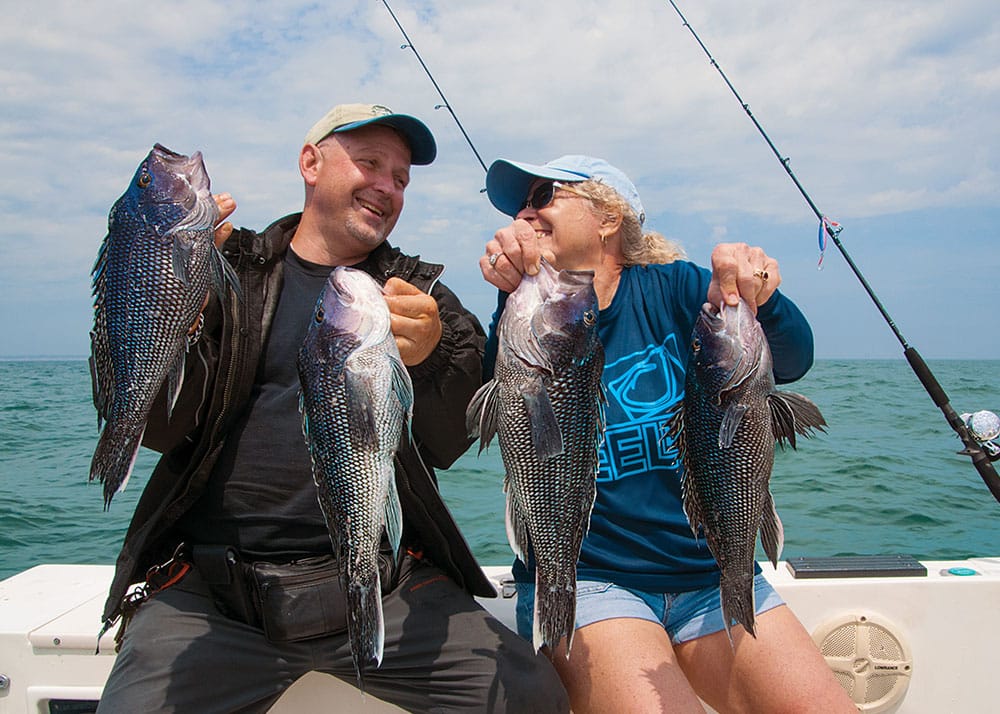
There was no mistaking the solid bite followed by the rhythmic bouncing. The hooked black sea bass took drag several times, digging hard to get back to the bottom. Then a second strike bent the slow-pitch rod over hard, the tip touching the water as another fish tried to make off with what it thought was an easy meal.
After some spirited give and take, the pair of humpbacks came over the rail and onto ice. A bunch more would fall to our light-tackle efforts that morning.
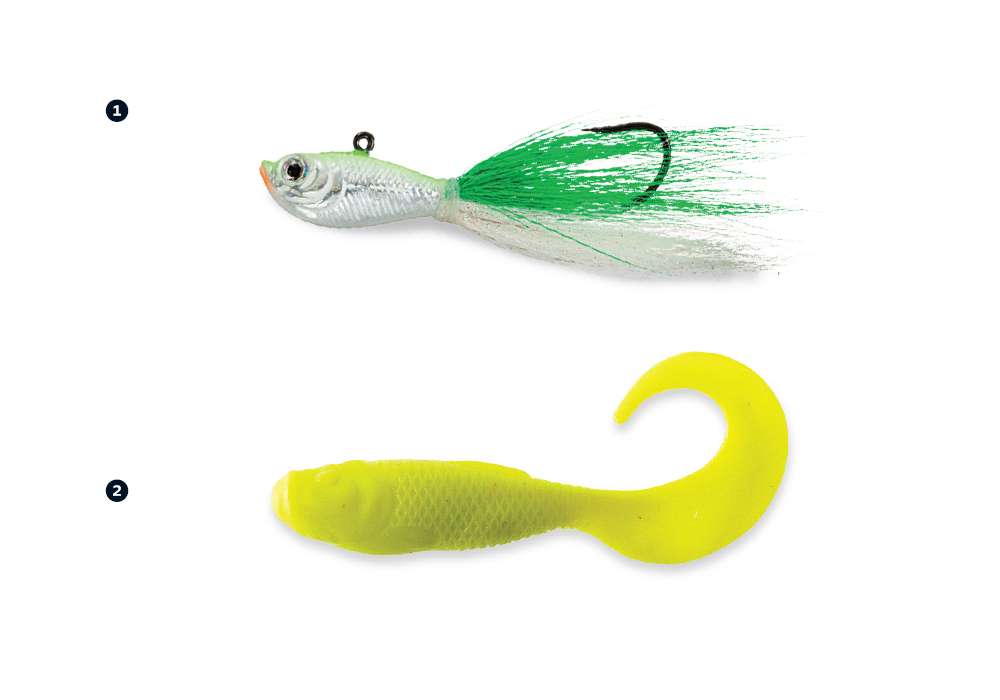
[2] Sweeten the jig with the addition of a Berkley Gulp! Swimming Mullet in lieu of the traditional squid strip. Salt Water Sportsman
The techniques we employed — bucktails on ultralight spinning tackle and center-weighted jigs on slow-pitch jigging outfits — are not like the black sea bass tackle of old: heavy conventional outfits loaded with thick monofilament, cut clams and heavy sinkers while you sit and hope you’re in the right spot. This is sea bass fishing for the 21st century — more productive, bigger fish, and more fun.
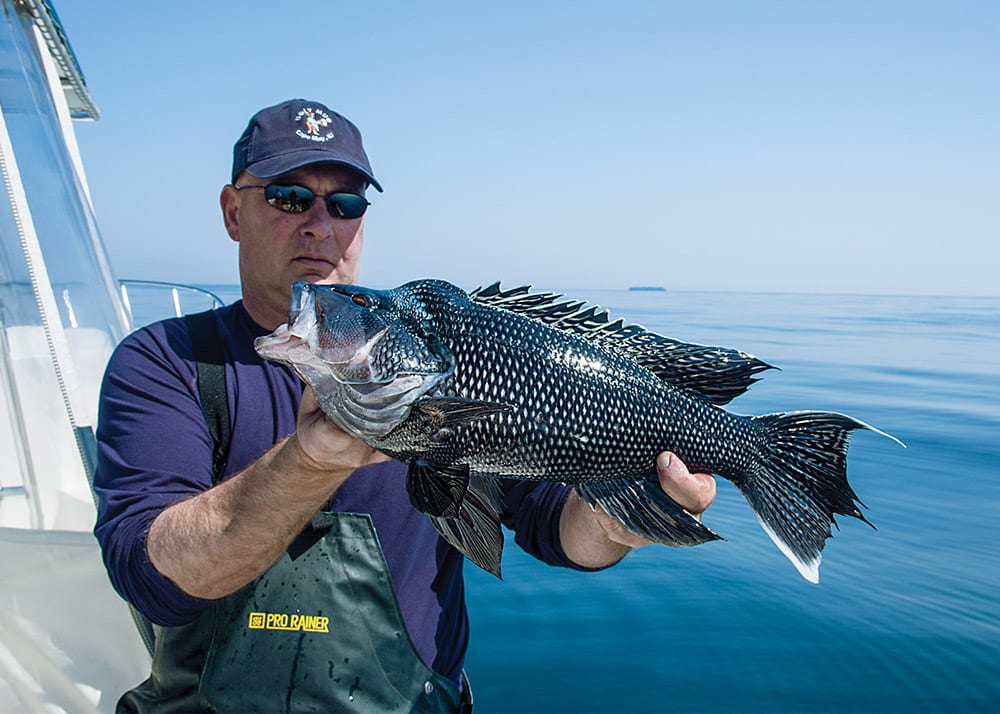
Soaring Stocks
Black sea bass have been popular with mid-Atlantic anglers since the first party boats started taking passengers over a hundred years ago. The current management is hotly debated because of perceived over-regulation of the recreational sector, even though the stocks have grown. A recent assessment indicates the fishery is well over twice the rebuilding target.
Read Next: Black Sea Bass Ceviche
As the stocks have grown, the species range has expanded considerably, and anglers in New England, who only a few years ago rarely saw a black sea bass, are catching them in great numbers. They are now so prevalent and such a sought-after species in Connecticut, Rhode Island and Massachusetts that they are quickly becoming a staple for anglers in the region.
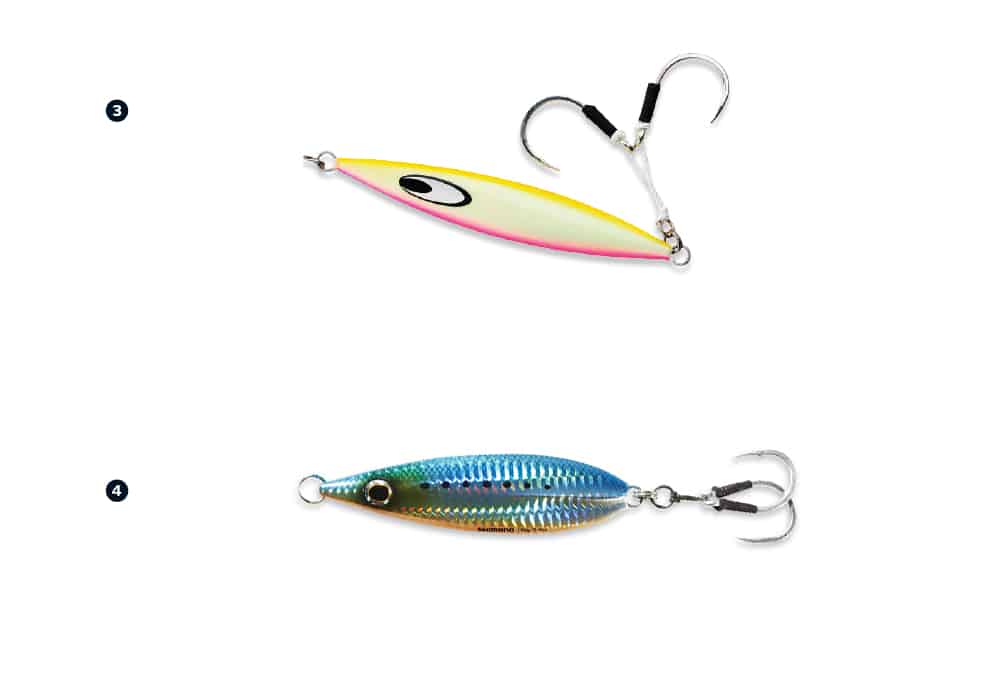
[4] The broad profile of Shimano’s Butterfly Flat-Fall lends itself to a slower, more controlled retrieve. Salt Water Sportsman
Black sea bass are structure-oriented but often venture considerable distances from hard bottom and well up the water column to feed. They forage on mussels, crabs and shrimp. The bigger they grow, the more predatory they become. With big heads and gaping jaws, they’ll eat anything that fits in their mouths. Light-tackle techniques play to that voracious behavior.
Read Next: Using Diamond Jigs for Black Sea Bass
Interestingly, modern techniques were developed with the advent of super-thin braided lines, which make it possible to use light bucktails and jigs to entice the fish while drifting in water 50 to 70 feet deep.
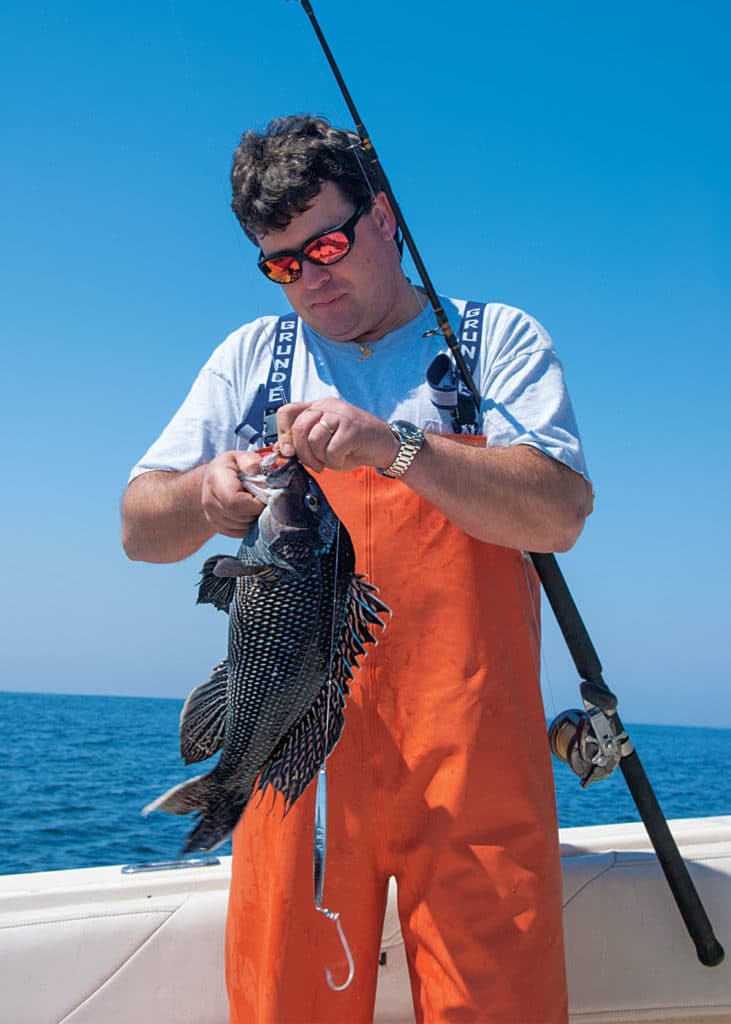
Twitch and Shout
Ultralight spinning tackle became the norm thanks to the advantages gained with 4- to 8-pound-test braid, which enables anglers to fish ½- to 2-ounce bucktails over deep structure. Not only are we now catching more and bigger fish, but we are having more fun doing it.
Rigging ultralight outfits is simple. Tie a 6-foot, 12- to 20-pound-test fluorocarbon leader to the braid with a double uni-knot and tie the lightest Tactical Anglers Power Clip to the tag end. Then tie a dropper loop about 18 inches above it, clip one leg and tie a second Power Clip to the other, so the dropper stands out from the main line about 6 inches. The clips make changing lure size and color simple. The bottom position gets a heavier bucktail, typically a 2- to 3-ounce, and the dropper gets a lighter one from ¼- to 1-ounce. Dress the jigs with Gulp! Swimming Mullet or shrimp bodies. A slender squid strip imparts additional action and scent. You can trade off Gulp! and squid or use both on the same jig.
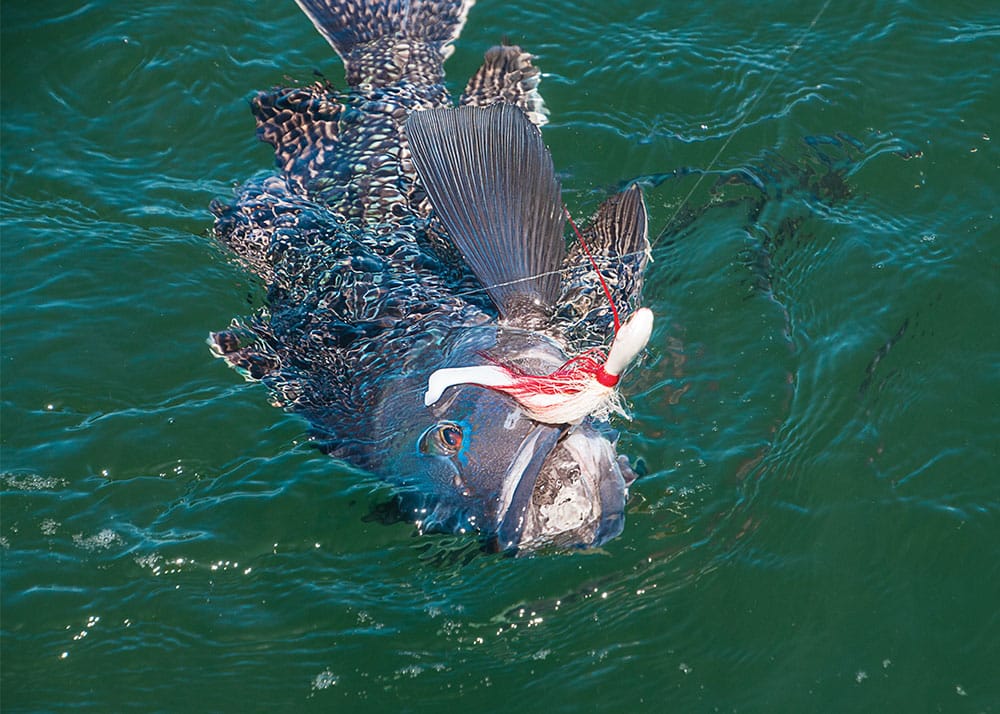
Once you drop your rig to the bottom, reel up a half-turn or more and bring them to life. A rhythmic lift and slow-drop swim the bucktails as the boat drifts. Watch the depth finder for structure and fish holding in the water column. Most of the time, they will be within a few feet of the bottom, but not always, so adjust the depth of your lures accordingly.
Another productive technique is to hold the rod horizontal to the water and twitch the tip at a quicker pace so the lighter jig on top dances while the heavier bottom jig barely moves. The twitching attracts violent strikes even when the fish are not feeding aggressively and tends to work best when the drift is slow. A Gulp! shrimp on the top jig can be deadly using this method.
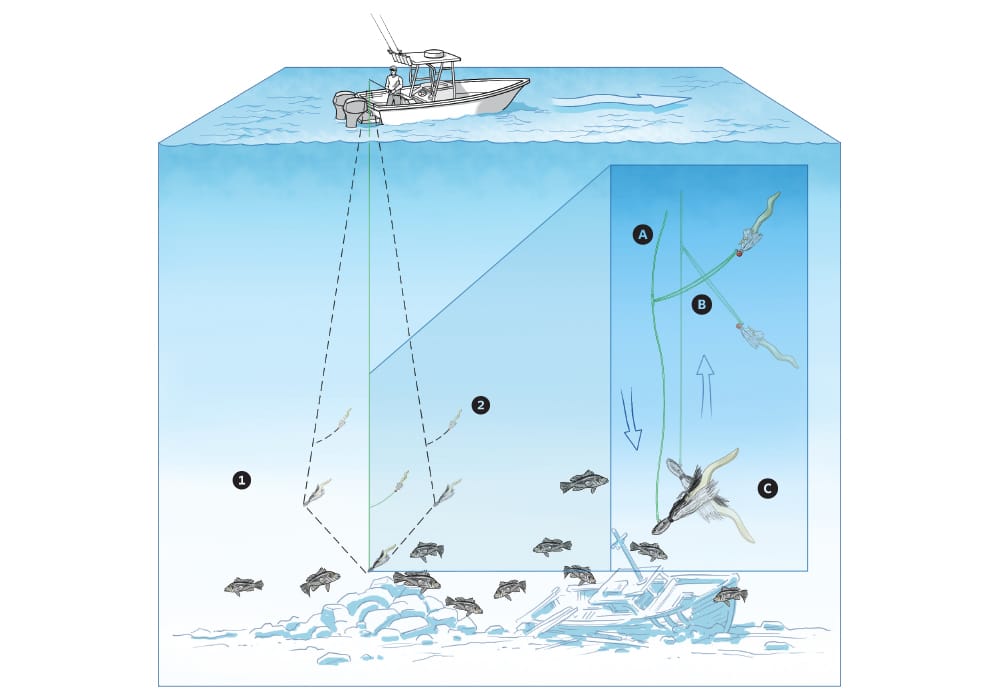
[2] Black sea bass suspend up to 15 feet above structure
[A] 6 feet of 12- to 20-pound leader
[B] 6-inch dropper with 1⁄4- to 1-ounce jig
[C] 2- to 3-ounce jig 18 inches below dropper Steve Sanford
Dance a Jig
The Japanese brought us the flutter-jig craze some years back, and now they have another take on jigging called “slow pitch.”
I was introduced to it by Dave Arbeitman of the Reel Seat Tackle Shop in Brielle, New Jersey, and it works well for sea bass, offering a slower target that swims and flutters in the strike zone on a horizontal plane. The tackle is specialized: light rods that bend from tip to butt, tiny reels with long handles that pick up a lot of line with each turn, and flat, center-weighted jigs. Action is generated by reeling to cause a deep bend in the rod that then slowly recovers, lifting the jig. A pause after each turn allows the jig to swim side to side. The technique even draws strikes from fish that are not actively feeding.
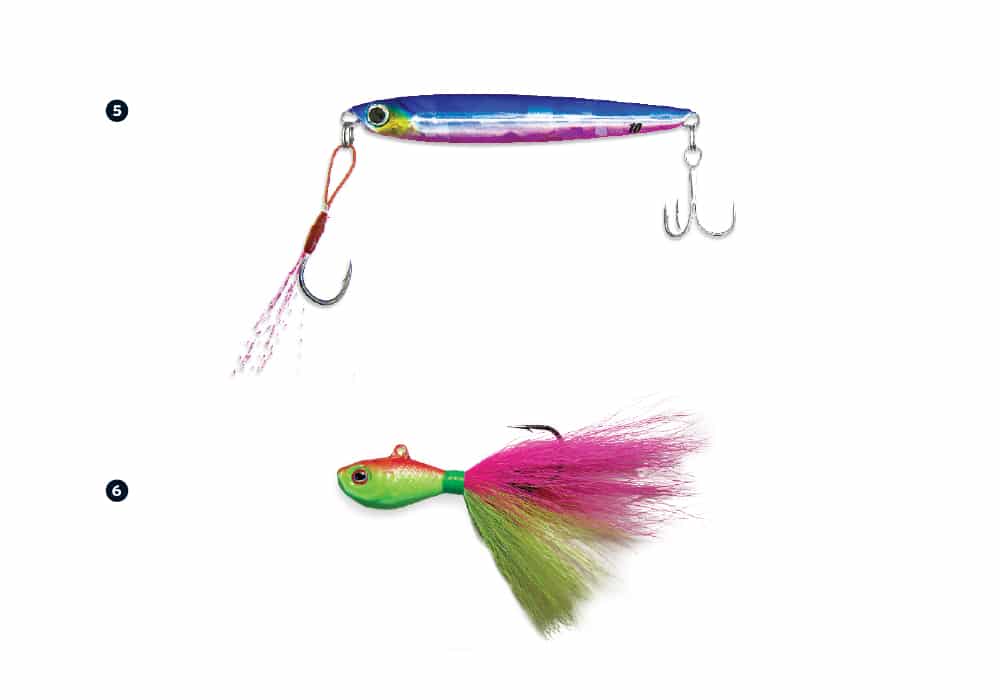
[6] Select jigs such as the S&S Rattletail, among others in the 1⁄2- to 2-ounce range, depending on conditions. Salt Water Sportsman
The two slow-pitch movements most commonly used are the reel-and-stop, varying the cadence as mentioned, effective when sea bass are in a broad band of the water column. The second is a more conventional high-lift-slow-drop, to keep the jig low in the water column when fish are holding tight to structure.
Read Next: Jumbo Black Sea Bass Fishing in New Jersey
Fighting fish on these noodlelike slow-pitch rods is a little different too. Tuck the rod butt under your arm and turn the reel handle, letting the deep flex of the rod tire and lift the fish.
The popularity of fishing for black sea bass continues to grow with stocks at historic levels and the range expanding northward on artificial and natural reefs, nearshore wrecks and rock piles, and in the winter, deeper hard-bottom areas offshore. These techniques add more fun to the catching by giving the aggressive critters the ability to show off their fighting prowess. Give them a try and you won’t go back to bait rigs any time soon.
SWS Planner:
What: Black sea bass
Where: Virginia through southern New England, nearshore 50- to 70-foot depths spring through fall, 200-plus feet in winter
When: Spring through early winter. Check regulations for each state’s season.
Who:
Cape May, New Jersey
Capt. Bob Cope
Full Ahead Charter
fullaheadsportfishing.com
Brielle, New Jersey
Jamaica, Paramount, Jamaica II, Bogans Basin (party boats) bogansbasin.com
SWS Tackle Box: Black Sea Bass: Slow-Pitch Jigging
Rod: Tsunami TSSPJ-C681H 6-foot-8-inch, 60- to 150-gram lures
Reel: Maxel Hybrid 25
Line: 6- to 8-pound braid with 12- to 20-pound fluoro leader
Lures: Daiwa Saltiga SK; Calissa Flatfall III; Major Craft Jigpara Micro Slim; Shimano Butterfly Flat-Fall, 60 to 150 grams
SWS Tackle Box: Black Sea Bass: Bucktailing
Rod: 6-foot light action, such as Lamiglas TFX6015S or G. Loomis SJR642; 5-foot-4-inch medium-fast action
Reel: Penn Battle II 2000, or equivalent
Line: 4- to 8-pound braid with 12- to 20-pound fluoro leader
Lures: Spro bucktail and mini bucktail; S&S Rattletail, FD and Big Eye series bucktails; Mustad Big Eye and Standard series bucktails, 1/4 to 3 ounces. Attach lures with Tactical Anglers 50-pound Power Clips
Bait: Slender squid strips; 3- and 4-inch Berkley Gulp! Swimming Mullet or Shrimp









